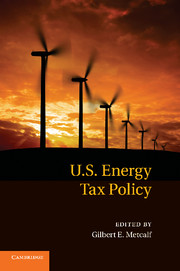Book contents
- Frontmatter
- Contents
- Conference Participants
- 1 Introduction
- 2 Distributional Impacts of Carbon Pricing Policies in the Electricity Sector
- 3 Distributional Impacts of a U.S. Greenhouse Gas Policy
- 4 Instrument Choice Is Instrument Design
- 5 Taxes, Permits, and Climate Change
- 6 Border Adjustments for Carbon Taxes and the Cost of Emissions Permits
- 7 Taxes and Caps as Climate Policy Instruments with Domestic and Imported Fuels
- 8 How Much Should Highway Fuels Be Taxed?
- 9 State Tax Policy and Oil Production
- 10 The Social Costs and Benefits of U.S. Biofuel Policies with Preexisting Distortions
- Index
- References
9 - State Tax Policy and Oil Production
The Role of the Severance Tax and Credits for Drilling Expenses
Published online by Cambridge University Press: 01 June 2011
- Frontmatter
- Contents
- Conference Participants
- 1 Introduction
- 2 Distributional Impacts of Carbon Pricing Policies in the Electricity Sector
- 3 Distributional Impacts of a U.S. Greenhouse Gas Policy
- 4 Instrument Choice Is Instrument Design
- 5 Taxes, Permits, and Climate Change
- 6 Border Adjustments for Carbon Taxes and the Cost of Emissions Permits
- 7 Taxes and Caps as Climate Policy Instruments with Domestic and Imported Fuels
- 8 How Much Should Highway Fuels Be Taxed?
- 9 State Tax Policy and Oil Production
- 10 The Social Costs and Benefits of U.S. Biofuel Policies with Preexisting Distortions
- Index
- References
Summary
Introduction
Although most energy-producing states have levied taxes on the value of oil, natural gas, and coal production for many years, changes in these taxes have become headline news as state governments grapple with budget shortfalls brought about by the current recession. For instance, Alaska has increased the severance tax on the value of its oil production and attempted to stimulate future production by allowing a credit against this tax for expenditures on capital items, including drilling rigs, infrastructure, exploration, and facility expansion (Alaska Department of Revenue 2008). In late 2008, California Governor Arnold Schwarzenegger proposed levying a 9.9 percent production tax on the value of most onshore oil production to help close a projected $24 billion budget deficit, but he subsequently reversed his position (Casselman 2009; Skelton 2009). The Pennsylvania legislature is considering a proposal to levy a 5 percent tax on the value of natural gas produced from the giant Marcellus shale deposit, but the bill is opposed by industry leaders who contend that it would result in 30 percent less drilling as well as revenue reductions to state and local governments totaling $880 million over the next decade (George 2009).
These measures, both enacted and proposed, raise a number of long-standing and important questions about the effects of state energy taxes that go well beyond their potential to provide a solid revenue base to support public services.
- Type
- Chapter
- Information
- US Energy Tax Policy , pp. 305 - 337Publisher: Cambridge University PressPrint publication year: 2010
References
- 8
- Cited by



